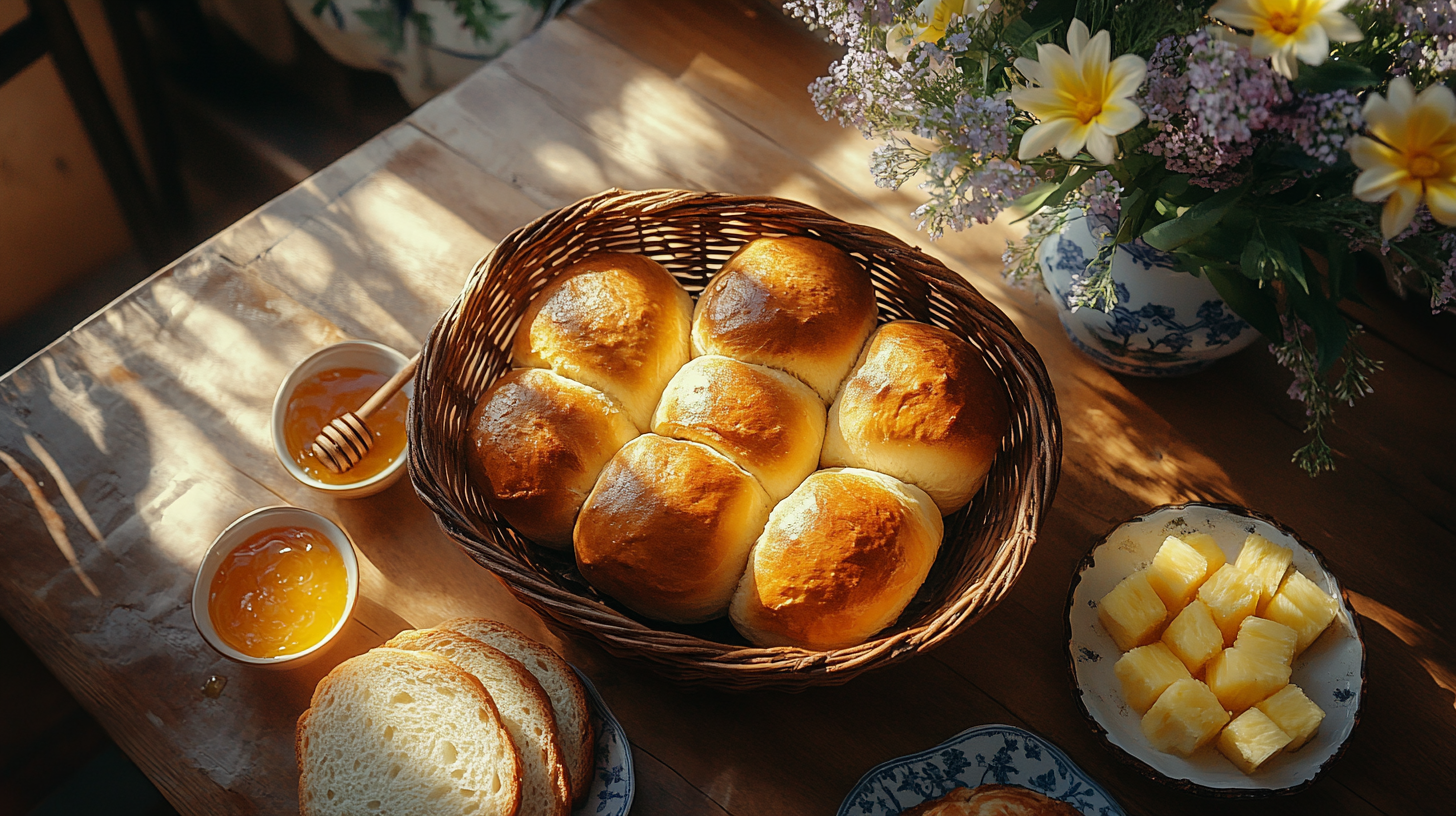Are Hawaiian rolls just brioche? This question often arises due to their rich flavor and soft texture. Hawaiian rolls originated in the 1950s, credited to Robert Taira, who founded King’s Hawaiian Bakery in Hilo, Hawaii. These sweet, pillowy rolls have become a breakfast staple in many households.
The unique character of Hawaiian rolls stems from their slightly sweet and tangy flavor profile, which comes from a mix of pineapple juice, sugar, and butter. These ingredients give them a soft, almost dessert-like quality. However, they retain a lightness that makes them ideal for pairing with savory breakfast dishes.
Key characteristics include:
- A tender crumb structure.
- Subtle sweetness without overpowering flavors.
- A golden-brown, slightly glossy exterior.
With their tropical inspiration and versatile use, Hawaiian rolls have become a beloved choice for breakfast menus around the world.
Table of Contents
What Is Brioche?
When asking, Are Hawaiian rolls just brioche?, it’s essential to understand what brioche is. Brioche is a French bread known for its rich, buttery flavor and airy texture, often used in breakfast and pastry recipes. This bread dates back to 15th-century France and has long been cherished for its luxurious qualities.
Brioche dough is enriched with butter and eggs, creating its signature soft texture and slightly sweet taste. While it shares some characteristics with Hawaiian rolls, brioche often leans more heavily on its buttery richness rather than sweetness.
Key features of brioche include:
- A flaky, light crumb that melts in your mouth.
- A golden, tender crust.
- Versatility for both sweet and savory applications, such as French toast or breakfast sandwiches.
Its unmistakable richness makes brioche a standout in the world of breakfast breads.

Comparing Hawaiian Rolls and Brioche
The comparison of Are Hawaiian rolls just brioche? requires an exploration of their ingredients, textures, and flavors. While both breads are enriched, they cater to different palates and preferences.
Similarities
- Both use enriched dough for softness and flavor.
- They share a slightly sweet taste, making them versatile for breakfast.
- Each has a golden-brown crust with a tender interior.
Differences
- Hawaiian rolls use pineapple juice for a tropical sweetness, while brioche relies on butter and eggs for richness.
- Brioche is denser and flakier, whereas Hawaiian rolls are lighter and fluffier.
- Hawaiian rolls often have a distinct tangy undertone absent in brioche.
Both are excellent choices, yet their unique characteristics mean they shine in different breakfast recipes.
Cultural and Culinary Significance
To address Are Hawaiian rolls just brioche?, their cultural and culinary roles must be considered. Hawaiian rolls reflect the tropical flavors and welcoming spirit of Hawaii, making them a symbol of hospitality and warmth. Their incorporation of pineapple juice mirrors the island’s abundant tropical fruits.
In contrast, brioche holds a prominent place in French cuisine, symbolizing indulgence and refinement. Its rich, buttery profile pairs well with classic French breakfasts like pastries or omelets.
Each bread brings its own cultural depth, making them iconic choices for breakfast.
Baking Hawaiian Rolls at Home
Curious home bakers often wonder, Are Hawaiian rolls just brioche?, leading them to experiment with baking. Making Hawaiian rolls at home allows you to replicate their softness and signature sweetness.
Ingredients:
- Pineapple juice for the distinct flavor.
- Butter for richness.
- Sugar for sweetness.
- Yeast and flour for structure.
Steps:
- Mix warm pineapple juice, sugar, and yeast.
- Add butter, eggs, and flour to form a soft dough.
- Allow the dough to rise until it doubles in size.
- Shape into rolls, let them rise again, and bake.
The result is a delightful breakfast treat that rivals store-bought varieties.
Baking Brioche at Home
To fully explore Are Hawaiian rolls just brioche?, try baking brioche at home. This process requires patience due to its enriched dough, but the result is worth the effort.
Ingredients:
- High-quality butter for richness.
- Eggs for a tender crumb.
- Sugar for mild sweetness.
- Yeast and flour for structure.
Steps:
- Combine warm milk, sugar, and yeast.
- Incorporate eggs, butter, and flour into the mixture.
- Knead the dough until smooth and elastic.
- Let the dough rise in a cool environment.
- Shape into loaves or rolls and bake until golden.
Homemade brioche elevates any breakfast with its luxurious texture and flavor.

Popular Uses of Hawaiian Rolls
Are Hawaiian rolls just brioche? often arises when considering their many uses. Hawaiian rolls are a breakfast favorite due to their adaptability and mild sweetness.
Common breakfast applications include:
- Breakfast sliders: Perfect for pairing with eggs and sausage.
- Toasted rolls: Excellent with butter and jam.
- Mini bread puddings: Ideal for soaking up custard mixtures.
Their subtle sweetness enhances both sweet and savory breakfast dishes.
Popular Uses of Brioche
When answering Are Hawaiian rolls just brioche?, consider how brioche enhances breakfast menus. Its buttery richness makes it ideal for gourmet preparations.
Popular breakfast uses include:
- French toast: Brioche soaks up batter beautifully.
- Breakfast sandwiches: A luxurious base for eggs and bacon.
- Breakfast pastries: Used in tarts and custard-filled treats.
Brioche’s versatility elevates any morning meal, offering an indulgent experience.
Are Hawaiian Rolls and Brioche Interchangeable?
Can Hawaiian rolls replace brioche in recipes? While they share similarities, the answer to Are Hawaiian rolls just brioche? reveals key differences that affect their interchangeability.
When they work as substitutes:
- For French toast, Hawaiian rolls offer a unique twist.
- Hawaiian rolls can mimic brioche’s softness in breakfast sandwiches.
When they don’t:
- Brioche’s richer profile may be preferred in pastries.
- Hawaiian rolls’ sweetness may not suit all savory recipes.
Understanding these nuances ensures you make the right choice for your breakfast needs.
The Commercialization of Hawaiian Rolls
The rise of Hawaiian rolls in the commercial market highlights their immense popularity and widespread appeal. While once a regional specialty in Hawaii, the commercialization of Hawaiian rolls began in earnest when Robert Taira expanded his bakery operations to the mainland United States. King’s Hawaiian is now synonymous with these sweet, fluffy rolls and dominates the market.
Key factors contributing to their commercialization include:
- Mass production techniques: Ensuring consistent quality and large-scale availability.
- Effective branding: The nostalgic and tropical branding appeals to a wide demographic.
- Versatility in breakfast menus: Their ability to complement sweet and savory dishes has increased their demand.
Additionally, Hawaiian rolls are heavily promoted during holidays and family gatherings, further solidifying their place in breakfast culture. Their packaging often highlights convenience, making them a favorite for quick, ready-to-serve meals.
The Commercialization of Brioche
The commercialization of brioche followed a slightly different path, steeped in tradition but adapted for modern tastes. While historically handcrafted by artisan bakers, the demand for brioche has driven its mass production, allowing it to reach breakfast tables worldwide.
Important aspects of brioche’s commercialization include:
- Global bakery chains: These have introduced brioche-inspired breakfast items like croissants and buns.
- Adaptability for packaged goods: Pre-sliced brioche loaves are now common in grocery stores.
- Premium branding: Brioche is often marketed as a luxury bread, appealing to those seeking indulgent breakfast options.
While some purists may argue that mass production dilutes its authenticity, commercialization has ensured that brioche remains a breakfast favorite for people from all walks of life.
Expert Opinions on Hawaiian Rolls and Brioche
When it comes to Are Hawaiian rolls just brioche?, culinary experts often weigh in on their distinct qualities. Chefs and food critics universally agree that these breads, while sharing some similarities, serve different purposes in breakfast menus.
Expert insights include:
- Hawaiian rolls are praised for their light, sweet flavor, which pairs well with tropical-inspired breakfasts.
- Brioche is often described as an “elevated” bread due to its richness and versatility in high-end breakfast dishes.
- Both are celebrated for their adaptability, but their distinct textures and flavors dictate their specific uses.
In blind taste tests, consumers frequently note the unique sweetness of Hawaiian rolls and the buttery depth of brioche, showcasing their individuality. Ultimately, experts suggest selecting the bread based on the desired breakfast experience.
Hawaiian Rolls vs Brioche: Taste and Texture
Are Hawaiian rolls just brioche? To answer this, we must examine their taste and texture. While they may seem similar at first glance, a closer look reveals notable differences.
Taste:
- Hawaiian rolls have a sweet, tangy flavor derived from pineapple juice and sugar.
- Brioche leans more toward buttery richness with a subtler sweetness.
Texture:
- Hawaiian rolls are light and fluffy, with a pillowy crumb.
- Brioche is slightly denser and flakier, with a melt-in-your-mouth quality.
For breakfast, Hawaiian rolls may appeal to those craving sweetness, while brioche suits those desiring indulgent richness. Understanding these contrasts ensures you select the right bread for your needs.
Pairing Hawaiian Rolls and Brioche with Dishes
Pairing breads with breakfast dishes can enhance the overall dining experience. Addressing Are Hawaiian rolls just brioche? reveals how their unique qualities lend themselves to specific pairings.
Hawaiian Rolls Pairings:
- Sweet: Spread with jam or honey for a quick breakfast treat.
- Savory: Ideal for breakfast sliders with scrambled eggs and sausage.
- Tropical: Pair with coconut or pineapple-based spreads for a thematic meal.
Brioche Pairings:
- Sweet: Perfect for French toast with powdered sugar and syrup.
- Savory: Complements gourmet breakfast sandwiches with smoked salmon or poached eggs.
- Pastry: Use as a base for custard tarts or chocolate-filled breakfast treats.
Both breads elevate breakfast dishes in their unique ways, making them indispensable in any kitchen.
Homemade Recipes for Hawaiian Rolls and Brioche
Crafting your own Hawaiian rolls and brioche at home can be a rewarding experience, allowing you to perfect their flavors and textures.
Hawaiian Rolls Recipe:
- Mix pineapple juice, sugar, and yeast until frothy.
- Add butter, eggs, and flour to form a soft dough.
- Let the dough rise, shape into rolls, and bake.
Brioche Recipe:
- Combine warm milk, sugar, and yeast to activate.
- Knead in eggs, butter, and flour for a rich dough.
- Chill, shape into rolls or loaves, and bake to golden perfection.
Homemade breads allow for customization, ensuring your breakfast experience is both personal and delicious.
FAQs
Are Hawaiian rolls the same as brioche?
No, Hawaiian rolls are not the same as brioche, although they share some similarities. Both are enriched breads, meaning they include ingredients like eggs and butter that create a soft texture and rich flavor. However, Hawaiian rolls have a distinct sweetness and a slightly tangy flavor due to the inclusion of pineapple juice and sugar in the recipe. Brioche, on the other hand, is known for its buttery richness and denser texture, without the fruity undertones found in Hawaiian rolls. Each bread serves different purposes and has unique characteristics.
What kind of bread are Hawaiian rolls?
Hawaiian rolls are a type of sweet, enriched bread. They are known for their soft, fluffy texture and subtle sweetness, which comes from the use of pineapple juice and sugar. These rolls are typically small, round, and golden-brown, with a tender crumb inside. Hawaiian rolls are versatile and commonly enjoyed as breakfast bread, often paired with jams, honey, or savory fillings like scrambled eggs and sausage. Their sweetness and lightness make them stand out from traditional white bread or dinner rolls.
What makes Hawaiian bread different from regular bread?
Hawaiian bread stands out from regular bread due to its unique combination of sweetness and slight tanginess, which is achieved by adding pineapple juice to the dough. Unlike regular bread, which often has a neutral or savory flavor, Hawaiian bread offers a tropical-inspired taste profile. It is also softer and fluffier than standard white or whole-grain bread, thanks to the use of butter and eggs in the recipe. This combination of sweet, tangy, and tender characteristics makes Hawaiian bread a favorite for breakfast and sweet-savory pairings.
Is Hawaiian bread the same as Portuguese bread?
Hawaiian bread and Portuguese bread share some similarities but are not the same. Hawaiian bread was inspired by Portuguese sweet bread, which is also enriched and slightly sweet. However, Hawaiian bread includes pineapple juice as a key ingredient, giving it a unique tropical flavor that Portuguese bread lacks. Portuguese bread tends to be slightly denser and less tangy than Hawaiian bread. While the two share a common ancestry, Hawaiian bread has evolved into its own distinct variety, tailored to Hawaiian flavors and preferences.
Conclusion
In conclusion, Are Hawaiian rolls just brioche? While both breads share certain characteristics, their differences in ingredients, texture, and flavor define them. Hawaiian rolls bring a sweet, tropical flair to breakfast, while brioche offers an indulgent, buttery experience. By understanding their unique qualities, you can confidently choose the right bread for your morning meal. Whether purchased or homemade, these breads are sure to enhance any breakfast table.
If you’re looking for a delicious way to use Hawaiian rolls, try our Hawaiian Roll French Toast recipe. It highlights their light, tender crumb and adds a sweet twist to a classic morning favorite. Perfect for pairing with fresh fruits or maple syrup, this dish makes breakfast unforgettable.


